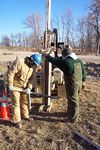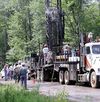
Summary of Drilling Methods to Collect Soil Samples for Infiltration Basins
Summary of drilling methods to collect soil samples for infiltration basins. Click on an image to enlarge.
Link to this table
| Drilling Method | Description | Sample Collection Possible | Depth | Advantages | Limitations | Photo reference/credit | Example Photo |
|---|---|---|---|---|---|---|---|
| Soil Probe | Soil probes are a basic form of soil sampling, used to collect shallow or surface samples by pushing a T-shaped probe into the ground. The probe cuts a core sample smaller than the diameter of the probe body. The sample can also be collected within a liner inside the probe. | Small diameter soil surface profile | ≤ 3 feet | Inexpensive Quick Easy to use | May not be able to collect enough information to determine if infiltration is possible due to depth and limited soil information collected. Unable to perform blow counts.1 | Iowa State University - University Extension | |
| Hand held or machine auger | The auger is held vertically and is driven into the ground and rotated by the handle while applying leverage. At every 30 cm of depth penetrated, the auger is taken out and the samples of the soils are collected separately for examination. This method works best in loose materials ranging from clay to sand to gravel. | Bag/jar samples of material | ≤ 50 feet | Inexpensive, Easy to use. Large selection of auger types | Only suitable for unconsolidated deposits (loose materials) Slow compared to other methods Equipment can be heavy. Unable to perform blow counts1. | University of New Hampshire - Institute for the Study of Earth, Oceans, and Space | |
| Excavation Test Pit or Trench | A pit or trench is dug manually or with an excavator to depth desired in order to visually observe subsurface soil conditions. | Grab samples or bulk samples of material | ≤ 20 feet | Quick, Easy to do, Shallow exploratory drilling method | Must be onsite during excavation to coordinate locations and depth as well as observe subsurface soils and behavior, taking photos and soil samples Shallow form of subsurface drilling Must be cautious of collapsable soils when digging Requires back fill and compaction. Unable to perform blow counts1. | United States Department of Agriculture - Natural Resources Conservation Service New Hampshire | |
| Direct Push Technology (DPT) | Geoprobe or Strataprobe is pnuematic hammer driven with continuous sampling into plastic tubes. Blow counts1 are not provided through this method. Single tube and dual tube systems are available. | Bag/jar samples of material | usually up to 60 feet but can go to over 100 feet | Minimal to no cuttings Quick and efficient Small, relatively mobile rig Continuous sampling | Unable to perform blow counts1 | Minnesota Pollution Control Agency | |
| Rotosonic | Rotosonic drilling is a method where continuous samples are taken. It is good for penetrating through most formations, but due to the ground disturbance, is not suitable for collecting undisturbed samples. Samples are brought out of the subsuface in clear plastic sleeves. | Bag samples of material | >100 feet | Continuous sampling Quick and efficient Produces little to no waste | Mobilization cost can be expensive. Unable to perform blow counts1. | United States Geological Survey - Eastern Mineral and Environmental Resources Science Center | |
| Standard Penetration Test (SPT) using Hollow Stem Auger (HSA) drilling method | Augers act as casing for borehole (prevent caving) Center of augers is hollow for sampling | Bag/jar sample Split-spoon (or other disturbed samples) Thin-wall samples (or other undisturbed samples) | >100 feet | Augers do not need to be removed to sample Can be used above and below water table. Can collect blow counts1. | Heaving sands may clog the hollow stem auger. Can be slow when drilling in soils with cobbles and boulders. | U.S. Department of Transportation - Federal Highway Administration |
1 For information on blow counts, link here or link here for table illustrating blow counts.
This page was last edited on 4 August 2022, at 17:49.





